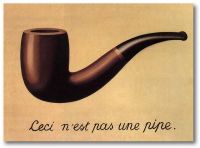Difference between revisions of "JCM312/The Avant-Garde (Discussion)"
From Screenpedia
Jump to navigationJump to search (updated; removed groups) |
|||
| Line 1: | Line 1: | ||
[[Image:TreasonOfImagesShadow.jpg|thumb|200px|right|René Magritte's ''The Treason of Images'' (1928-9).]] | [[Image:TreasonOfImagesShadow.jpg|thumb|200px|right|René Magritte's ''The Treason of Images'' (1928-9).]] | ||
| − | # | + | #Why were surrealists obsessed with dreams and the insane? What does Robert Hughes mean when he characterizes "neurosis" as "the permanent involuntary form of dreams"? |
| − | # | + | #René Magritte's ''The Treason of Images'' (1928-9) contains the phrase, "Ceci n'est pas une pipe" ("This is not a pipe"). What does Hughes feel is the significance of this phrase? |
| − | # | + | #How does Hughes characterize the surrealist use of sexuality? |
| − | # | + | #What previously dismissed forms of art (what Hughes calls, "kinds of expression") did surrealists advocate for? Why? |
#What elements of surrealism do you see in the films we viewed in class? | #What elements of surrealism do you see in the films we viewed in class? | ||
| − | #* | + | #*''Entr'Acte'' (Clair, 1924) |
| − | #* | + | #*''Un Chien Andalou'' (Buñuel/Dalí, 1928) |
| − | #* | + | #*''Zero for Conduct'' (Vigo, 1933) |
#How do Bordwell and Thompson characterize the main principles of surrealist film? | #How do Bordwell and Thompson characterize the main principles of surrealist film? | ||
#Hughes maintains that "The [surrealist] object was collage in three dimensions" (p. 241). What do you think he means by this? (Meret Oppenheim's ''Luncheon in Fur'' is one example.) | #Hughes maintains that "The [surrealist] object was collage in three dimensions" (p. 241). What do you think he means by this? (Meret Oppenheim's ''Luncheon in Fur'' is one example.) | ||
| Line 15: | Line 15: | ||
==External links== | ==External links== | ||
| − | *[http://www.tcf.ua.edu/Classes/Jbutler/T340/SurrealismLecture. | + | *[http://www.tcf.ua.edu/Classes/Jbutler/T340/SurrealismLecture.php Dada & Surrealism Illustrations] |
[[Category:TCF340 Discussion]] | [[Category:TCF340 Discussion]] | ||
Revision as of 14:20, 18 September 2012
- Why were surrealists obsessed with dreams and the insane? What does Robert Hughes mean when he characterizes "neurosis" as "the permanent involuntary form of dreams"?
- René Magritte's The Treason of Images (1928-9) contains the phrase, "Ceci n'est pas une pipe" ("This is not a pipe"). What does Hughes feel is the significance of this phrase?
- How does Hughes characterize the surrealist use of sexuality?
- What previously dismissed forms of art (what Hughes calls, "kinds of expression") did surrealists advocate for? Why?
- What elements of surrealism do you see in the films we viewed in class?
- Entr'Acte (Clair, 1924)
- Un Chien Andalou (Buñuel/Dalí, 1928)
- Zero for Conduct (Vigo, 1933)
- How do Bordwell and Thompson characterize the main principles of surrealist film?
- Hughes maintains that "The [surrealist] object was collage in three dimensions" (p. 241). What do you think he means by this? (Meret Oppenheim's Luncheon in Fur is one example.)
Bibliography
- Hughes, Robert. The Shock of the New. NY: Alfred A. Knopf, 1980.
